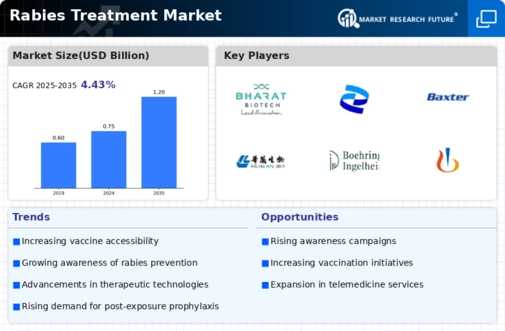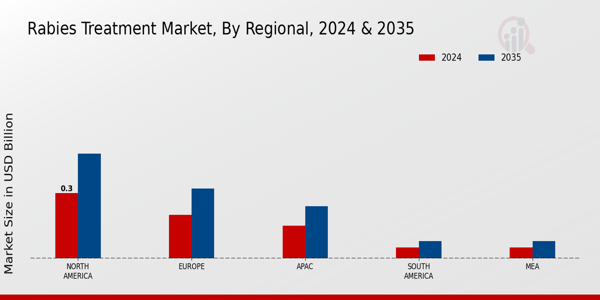Rising Awareness and Education
The growing awareness and education regarding rabies transmission and prevention are pivotal for the Global Rabies Treatment Market Industry. Public health campaigns aimed at educating communities about the dangers of rabies and the importance of vaccination are becoming more prevalent. This heightened awareness is likely to lead to increased demand for rabies treatments, as individuals seek preventive measures following potential exposure. Educational initiatives by organizations such as the World Health Organization are instrumental in this regard. As awareness continues to rise, the market is expected to expand, driven by informed consumer choices.
Emerging Markets and Urbanization
The rapid urbanization and economic development in emerging markets are contributing to the growth of the Global Rabies Treatment Market Industry. As urban populations increase, the interaction between humans and animals, particularly stray dogs, becomes more frequent, raising the risk of rabies transmission. Countries in Asia and Africa are witnessing a surge in rabies cases due to inadequate vaccination coverage among pets. This situation creates a pressing need for effective rabies treatment solutions. The market's expansion in these regions is anticipated to be significant, driven by the urgent demand for rabies vaccines and treatments.
Advancements in Vaccine Technology
Innovations in vaccine technology are significantly influencing the Global Rabies Treatment Market Industry. The development of more effective and safer rabies vaccines, such as recombinant vaccines, has the potential to enhance immunization rates. These advancements not only improve the efficacy of rabies prevention but also reduce the incidence of adverse reactions. As healthcare providers adopt these new vaccines, the market is expected to grow, with projections indicating a value of 1.2 USD Billion by 2035. This growth is indicative of the ongoing commitment to improving rabies treatment and prevention strategies worldwide.
Government Initiatives and Funding
Government initiatives aimed at rabies control and prevention are crucial drivers for the Global Rabies Treatment Market Industry. Many countries are implementing national rabies control programs that include vaccination campaigns for pets and public education on rabies prevention. For instance, the Centers for Disease Control and Prevention in the United States has launched various programs to reduce rabies incidence. Increased funding for these initiatives is likely to bolster the market, as it encourages the development and distribution of effective rabies treatments. The anticipated growth rate of 4.37% CAGR from 2025 to 2035 reflects the positive impact of these government efforts.
Increasing Incidence of Rabies Cases
The rising incidence of rabies cases globally is a primary driver for the Global Rabies Treatment Market Industry. According to the World Health Organization, rabies causes approximately 59,000 deaths annually, predominantly in developing regions. This alarming statistic underscores the urgent need for effective treatment options. As awareness of rabies transmission through animal bites grows, particularly in areas with high dog populations, the demand for rabies vaccines and post-exposure prophylaxis is likely to increase. The market is projected to reach 0.75 USD Billion in 2024, reflecting the heightened focus on rabies prevention and treatment.






















